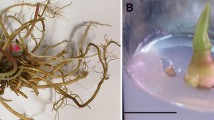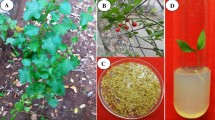Abstract
Adventitious shoot buds were induced directly without intervening callus phase from the cut edge of the ‘aged leaves’ explants as well as via nodular meristemoids from the cut edge of the ‘young leaves’ of Tylophora indica an endangered medicinal climber of the family Asclepiadaceae. Shoot primordia developed directly from the cut edge of the ‘aged leaf’ explant without any callus phase within 26–30 days and maximum 18.6 ± 0.36 shoot per explant were induced on Murashige and Skoog (MS) medium supplemented with 2.0 mg/l 6-benzyl-aminopurine (BAP). Whereas maximum 25.2 ± 0.57 shoots per explant were produced from ‘young leaf’ explant via nodular meristemoids on 2.0 mg/l BAP and 0.2 mg/l indole-3-acetic acid fortified medium within 40–45 days. Multiplied shoots were successfully rooted with maximum 8.3 ± 0.36 root per shoot with 15.5 ± 0.44 cm length on half strength MS medium supplemented with 0.2 mg/l indole-3-butyric acid. Finally, the rooted plants were hardened and transferred to soil with a 93.3 % success rate. After 18 months of field transfer, a 69.0 % of regenerated plants produce flowers and 28.5 % produce fruits. Seeds of these fruits show 78.3 % viability more or less similar with in vivo grown plants with 71.7 % viability on in vitro germination, which ensures the fertility of the regenerants. These regenerated plants were conserved in vitro for up to 21 months without sub-culturing in presence of osmoticums (Mannitol and Sorbitol) and best results found on MS medium supplemented with 3 % sucrose and 2 % mannitol, where 53.3 ± 3.33 % plants survive up to 21 months and 86.7 ± 3.33 % of these survived plants could turn to normal plants after a re-growth for 2 month which showed no obvious difference in morphology. Further, clonal fidelity assessment of the micropropagated plants was carried out using cytological studies as well as using randomly amplified polymorphic DNA (RAPD) markers analysis. All the micropropagated plants have shown normal diploid 2n = 22 chromosomes, same as that of the mother plant. A result of RAPD markers analysis indicates all the regenerants are true-to-type and there were no somaclonal variations among these regenerants.




Similar content being viewed by others
References
Gupta M, Mukhtar HM, Ahmad S (2010) Phyto-pharmacological and plant tissue culture overview of Tylophora indica (burm f.) Merill. J Pharm Sci Res 2:401–411
Gurav S, Devprakash, Senthilkumar GP, Tembare R, Mani T (2011) Tylophora indica: a review on its ethnobotany, phytochemical and pharmacological profile. Asian J Biochem Pharm Res 1:405–414
Faisal M, Ahmad N, Anis M (2007) An efficient micropropagation system for Tylophora indica: an endangered, medicinally important plant. Plant Biotechnol Rep 1:155–161
Islam AS (2009) Utilization of indigenous medicinal plants and their conservation in Bangladesh. In: Akerele O, Heywood V, Synge H (eds) The conservation of medicinal plants. Cambridge University Press, New York, p 323
Engelmann F (1991) In vitro conservation of tropical plant germplasm—a review. Euphytica 57:227–243
Bunn E, Turner SR, Panaia M, Dixon KW (2007) The contribution of in vitro technology and cryogenic storage to conservation of indigenous plants. Aust J Bot 55:345–355
Pence VC (2011) Evaluating costs for the in vitro propagation and preservation of endangered plants. In Vitro Cell Dev Biol Plant 47:176–187
Fay MF (1992) Conservation of rare and endangered plants using in vitro methods. In Vitro Cell Dev Biol Plant 28:1–4
Sarasan V, Cripps R, Ramsay MM, Atherton C, McMichen M, Prendergast G, Rowntree JK (2006) Conservation in vitro of threatened plants—progress in the past decade. In Vitro Cell Dev Biol Plant 42:206–214
Al-Mahmood HJ, Shatnawi MA, Shibli RA, Makhadmeh IM, Abubaker SM, Shadiadeh AN (2012) Clonal propagation and medium-term conservation of Capparis spinosa: a medicinal plant. J Med Plants Res 6:3826–3836
Negash A, Krens F, Schaart J, Visser B (2001) In vitro conservation of enset under slow-growth conditions. Plant Cell Tissue Organ Cult 66:107–111
Montalvo-Peniche MC, Iglesias-Andreu LG, Mijangos-Corte′s JO, Nahuat-Dzib SL, Barahona-Pe′rez F, Canto-Flick A, Santana-Buzzy N (2007) In vitro germplasm conservation of habanero pepper (Capsicum chinense jacq.). Hortic Sci 42:1247–1252
Holobiuc I, Mitoi M, Blindu R, Helepciuc F (2010) The establishment of an in vitro gene bank in Dianthus spiculifolius schur. and D. glacialis ssp. gelidus (schott nym. et kotschy) tutin: II. medium term cultures characterization in minimal growth conditions. Romanian Biotechnol Lett 15:5111–5119
Engelmann F (2011) Use of biotechnologies for the conservation of plant biodiversity. In Vitro Cell Dev Biol Plant 47:5–16
Sharma N, Chandel KPS (1992) Effect of ascorbic acid on axillary shoot induction in Tylophora indica (burm. f.) merrill. Plant Cell Tissue Organ Cult 29:109–113
Faisal M, Anis M (2003) Rapid mass propagation of Tylophora indica via leaf callus culture. Plant Cell Tissue Organ Cult 75:125–129
Faisal M, Anis M (2005) An efficient in vitro method for mass propagation of Tylophora indica. Biol Plant 49:257–260
Chaudhuri KN, Ghosh B, Jha S (2004) The root: a potential new source of competent cells for high-frequency regeneration in Tylophora indica. Plant Cell Rep 22:731–740
Thomas TD, Philip B (2005) Thidiazuron-induced high-frequency shoot organogenesis from leaf-derived callus of a medicinal climber, Tylophora indica (burm. f.) merrill. In Vitro Cell Dev Biol Plant 41:124–128
Thomas TD (2009) Isolation, callus formation and plantlet regeneration from mesophyll protoplasts of Tylophora indica (burm. f.) merrill: an important medicinal plant. In Vitro Cell Dev Biol Plant 45:591–598
Jayanthi M, Mandal PK (2001) Plant regeneration through somatic embryogenesis and RAPD analysis of regenerated plants in Tylophora indica (burm. F.) merrill. In Vitro Cell Dev Biol Plant 37:576–580
Sahai A, Shahzad A, Anis M (2010) High frequency plant production via shoot organogenesis and somatic embryogenesis from callus in Tylophora indica, an endangered plant species. Turk J Bot 34:11–20
Cheruvathur MK, Abraham J, Thomas TD (2013) Plant regeneration through callus organogenesis and true-to-type conformity of plants by RAPD analysis in Desmodium gangeticum (Linn.) DC. Appl Biochem Biotechnol 169:1799–1810
Asthana P, Jaiswal VS, Jaiswal U (2011) Micropropagation of Sapindus trifoliatus L. and assessment of genetic fidelity of micropropagated plants using RAPD analysis. Acta Physiol Plant 33:1821–1829
Mohanty S, Parida R, Singh S, Joshi RK, Subudhi E, Nayak S (2011) Biochemical and molecular profiling of micropropagated and conventionally grown Kaempferia galangal. Plant Cell Tiss Organ Cult 106:39–46
Roy AR, Sajeev S, Pattanayak A, Deka BC (2012) TDZ induced micropropagation in Cymbidium giganteum Wall. Ex Lindl. and assessment of genetic variation in the regenerated plants. Plant Growth Regul 68:435–445
Kumar A, Prakash K, Sinha RK, Kumar N (2013) In vitro plant propagation of Catharanthus roseus and assessment of genetic fidelity of micropropagated plants by RAPD marker assay. Appl Biochem Biotechnol 169:894–900
Murashige T, Skoog F (1962) A revised medium for rapid growth and bioassays with tobacco tissue culture. Physiol Plant 15:437–497
Stewart CN Jr, Via LE (1993) A rapid CTAB DNA isolation technique useful for RAPD fingerprinting and other PCR applications. Bio Techniques 14:748–749
Neumann KH, Kumar A, Imani J (2009) Plant cell and tissue culture-a tool in biotechnology, principles and practice. Springer-Verlag, Heidelberg, pp 139–143
Sarwar M, Skirvin RM (1997) Effect of thidiazuron and 6-benzylaminopurine on adventitious shoot regeneration from leaves of three strains of ‘McIntosh’ apple (Malus × domestica borkh) in vitro. Sci Hortic 68:95–100
Northmore JA, Zhou V, Chuong SDX (2012) Multiple shoot induction and plant regeneration of the single-cell C4 species Bienertia sinuspersici. Plant Cell Tissue Organ Cult 108:101–109
Ma GH, He CX, Ren H, Zhang QM, Li SJ, Zhang XH, Eric B (2010) Direct somatic embryogenesis and shoot organogenesis from leaf explants of Primulina tabacum. Biol Plant 54:361–365
Gaspar TH, Kevers C, Penel C, Greppin H, Reid DM, Thorpe TA (1996) Plant hormones and plant growth regulators in plant tissue culture. In Vitro Cell Dev Biol Plant 32:272–289
Gaspar TH, Kevers C, Faivre-rampant O, Crevecoeur M, Penel C, Greppin H, Dommes J (2003) Changing concepts in plant hormone action. In Vitro Cell Dev Biol Plant 39:85–106
Melara MV, Arias AMG (2009) Effect of BAP and IAA on shoot regeneration in cotyledonary explants of Costa Rican melon genotypes. Agronomía Costarricense 33:125–131
Majumder S, Rahman MM, Bhadra SK (2011) Micropropagation of Scoparia dulcis linn. through induction of indirect organogenesis. Asia Pac J Mol Biol Biotechnol 19:11–17
Rajasekharan PE, Ambika SR, Ganeshan S (2009) In-vitro conservation of Tylophora indica: a threatened medicinal plant. IUP J Genet Evol 2:26–35
Dube P, Gangopadhyay M, Dewanjee S, Ali MN (2011) Establishment of a rapid multiplication protocol of Coleus forskohlii briq. and in vitro conservation by reduced growth. Indian J Biotechnol 10:228–231
Golmirzaie A, Toledo J (1998) Non-cryogenic, long-term germplasm storage. In: Hall R (ed) Methods in molecular biology, vol 111., Plant cell culture protocols, Humana Press, Netherlands, pp 95–101
Dodds JH, Roberts LW (1985) Experiments in plant tissue culture, 2nd edn. Cambridge University press, Cambridge
Tahtamouni RW, Shibli RA, Ajlouni MM (2001) Growth responses and physiological disorders in wild pear (Pyrus syriaca Boiss.) during slow-growth in vitro preservation on osmostressing media. Plant Tissue Cult 11:15–23
Thompson MR, Douglas TJ, Sasamoto HO, Thorpe TA (1986) Mannitol metabolism in cultured plant cells. Physiol Plant 67:365–369
Harb A, Krishnan A, Ambavaram MMR, Pereira A (2010) Molecular and physiological analysis of drought stress in Arabidopsis reveals early responses leading to acclimation in plant growth. Plant Physiol 154:1254–1271
Feng X, Zhao P, Hao J, Hu J, Kang D, Wang H (2011) Effects of sorbitol on expression of genes involved in regeneration of upland rice (Oryza sativa L.). Plant Cell Tissue Organ Cult 106:455–463
Haque SM, Ghosh B (2013) Micropropagation, in vitro flowering and cytological studies of Bacopa chamaedryoides, an ethno-medicinal plant. Environ Exp Biol 11:59–68
Kaur H, Anand M, Goyal D (2011) Optimization of potting mixture for hardening of in vitro raised plants of Tylophora indica to ensure high survival percentage. Int J Med Arom Plants 1:83–88
Samaddar T, Nath S, Halder M, Sil B, Roychowdhury D, Sen S, Jha S (2012) Karyotype analysis of three important traditional Indian medicinal plants, Bacopa monnieri, Tylophora indica and Withania somnifera. Nucleus 55:17–20
Saker MM, Bekheer SA, Taha HS, Fahmy AS, Moursy HA (2000) Detection of somaclonal variations in tissue cultured-derived date palm plants using iso-enzyme analysis and RAPD fingerprints. Biol Plant 43:347–351
Chaturvedi P, Chowdhary A, Kawalkar H (2012) Molecular characterization of Tylophora indica regenerated plants in vitro by RAPD and ISSR analysis. Int J Res Phytochem Pharmacol 2:175–179
Acknowledgments
We thank Swami Kamalasthananda, Principal of our college for facilities provided in this work. The Financial assistance from West Bengal Biodiversity Board (WBBB), Govt of West Bengal [Sanction No. 52/3k(Bio)-3/2008] is gratefully acknowledged.
Author information
Authors and Affiliations
Corresponding author
Rights and permissions
About this article
Cite this article
Haque, S.M., Ghosh, B. Field Evaluation and Genetic Stability Assessment of Regenerated Plants Produced Via Direct Shoot Organogenesis from Leaf Explant of an Endangered ‘Asthma Plant’ (Tylophora indica) Along with Their In Vitro Conservation. Natl. Acad. Sci. Lett. 36, 551–562 (2013). https://doi.org/10.1007/s40009-013-0161-z
Received:
Revised:
Accepted:
Published:
Issue Date:
DOI: https://doi.org/10.1007/s40009-013-0161-z




